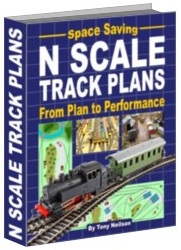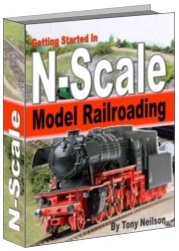How Do N Scale Locomotives Compare?
The locomotive is arguably the most interesting part of the train. It is the engine that makes everything go as it pulls its cargo and passengers along the rails. N scale DCC locomotives recreate the feeling of being next to the tracks and seeing the locomotives pass on their way to faraway places.
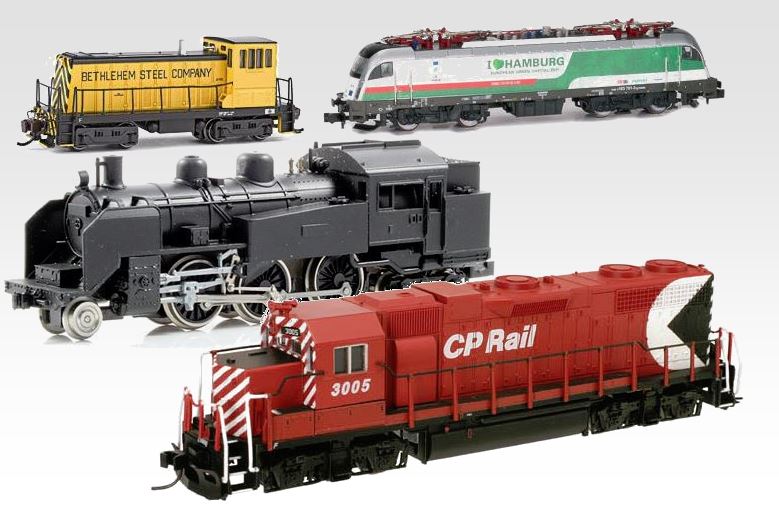
Clockwise from the top: Bachmann-Spectrum-GE70 Locomotive, BR183 Tarus Electric Locomotive, Kato N Gauge 202 C11 264 Steam Engine, Atlas N GP-38-40 loco.
Today, there are N scale locomotives with DCC and sound that represent modern trains and those from days gone by as well. For the enthusiast who wants to recreate to scale a modern town, the Old West or some point in-between, the N scale locomotive is a good place to start.
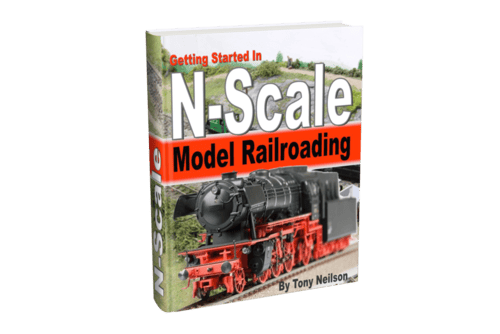
What is N Scale?
The different sizes of model railroad tracks have designations such as N, HO, Z and so forth. The confusion between the terms “n scale” and “n gauge” is common and it is not surprising. N gauge refers to the dimension of the track, however in the United Kingdom “N gauge” refers to 1:148 scale with 9mm (0.354 inch) distance between the track rails. In the USA N scale is 1:160 with the same 9mm between rails. In the USA an N scale locomotive for example would need to be enlarged 160 times (1:160) for it to be the same size as a real locomotive. In the UK an N scale engine would need to be enlarged 148 times (1:148) to make it the same size as the same engine in the real world.
So, with the confusion on Ngauge / Nscale sizing in different countries, it is not surprising that model railroaders typically interchange the terms. If they live in the US they are likely to be referring to a 1:160 scale model with a 9mm gauge between the tracks. In the UK they are likely to be referring to a 1:148 scale model with 9mm track gauge.
To further confuse things; the scale is very similar to 2mm Finescale which is 1:152 scale with a 9.42mm gauge; and Japanese Ngauge which is 1:150 and 9mm gauge.
The German model train manufacturer Arnold is the originator of the N scale term as the “N” is short for “Neun” which is the German word for “Nine” which is the scale in millimeters that the tracks are offered.
In model railroading an nscale 40 foot box-car would be about 3.25 inches long, .75 inch wide, and 1 inch high. As a real life comparison the external dimensions of a 40ft boxcar are likely to be around 41ft 10 inches long x 10ft 8 inches wide x 14ft 6 inches high.
Obviously dimensions vary a little depending on the car type as there are many different styles including, single door boxcars, double door boxcars, hydra cushion boxcars, and insulated boxcars. They carry a range of freight including: timber, auto parts, food products, general freight, pulp and paper etc.
Now let’s compare the size of a real world locomotive to its miniature n scale counterpart. The Dash 8-40CW diesel engine is a loco many are familiar with. Union Pacific started with them in 1990 and GE built 756 of them before they were superseded in 1994 by the Dash 9 44CW.
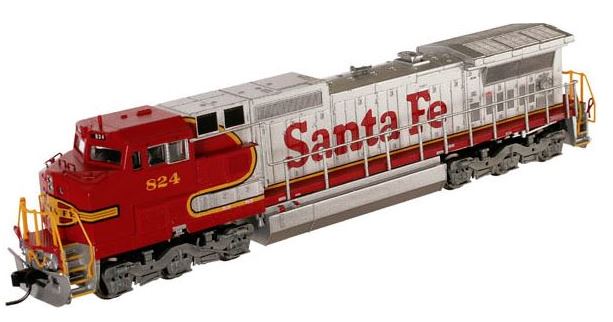
Diesel N Scale Locomotive
The original Dash 8 40CW was powered with a 3,000 kW (4,000 horsepower) diesel engine giving a top speed of around 70 mph (110 km/h). The engine typically carried around 5000 gallons (18927 liters) of diesel, 410 gallons (1,552 liters) of lubrication oil, and 380 gals (1,438 liters) of coolant.
A Dash 8-40CW loco is 70 ft 8 inch (21.54 meters) long x 15 ft 4 inch (4.67 meters) high x 10 ft 2 inch (3.10 meters) wide.
The same Dash 8-40CW diesel engine in US N scale would reduce down to 5.3 inches long x 1.150 inches high x .762 inches wide, although the actual scale size of the models might vary somewhat. Dash 8-40CW N scale engines can be purchased in the popular BNSF, Heritage, Conrail, CSX, or Santa Fe liveries. Now, back to where we left off…
The origins of the N scale for model railroads are not well documented, but generally speaking they started in earnest in the early 1960s. Because many of the N scale models, railroads, locomotives and the like were smaller than their HO counterparts, they were generally seen as “toy trains” by many who were used to larger, more detailed models.
However, N scale gained steam so to speak by the 1980s when better manufacturing methods, higher quality items and the advantages of the smaller scale became a much larger part of the model railroad hobby as a whole. Today, N scale is one of the most respected because it is large enough to hold many details while small enough to fit into many homes.

n scale model railroaders worldwide.
N Scale Steam Locomotives
The days of steam locomotives represent a bygone era that was the golden age of the railroad. Steam locomotives are distinguished by their design and with steam that emanates from the smokestack itself as the train is in operation.
Steam locomotives are perfect for recreating the 19th century as train tracks crisscrossed the countryside and represented the primary way that people, cattle and cargo moved around the country until the advent of the automobile and airplane. The steam locomotives from the major manufacturers in the hobby are very detailed and some include the ability to recreate the smoke or steam from the engine.
Brands of N Scale Locomotives
There are a number of brands in the US and around the world that manufacture N scale locomotives with DCC. Either found in trains sets of sold individually, there are a large number of locomotives available in this scale that fit a wide variety of uses. What follows is just a short sampling of the many different brands and manufacturers that offer locomotives of this size.
– Arnold
– Atlas
– Bachmann
– BLMA
– CJM
– Kato
– Life-Like
– Lionel
– Williams & More
The different brands are found around the world and have different models and prices as well. The availability of the brands will depend on the means in which you make the purchase as well as the location. Many brick and mortar hobby stores will only carry a select few in stock while online outfits will often have access to more, especially from the manufacturer.
The Advantages of the N Scale Locomotive
The advantages that these type of locomotives enjoy is tied directly into the advantages of the scale itself. Generally speaking, N scale is small so a layout costs less to build than a much bigger HO or OO scale railroad. The lower cost, greater flexibility and wide variety of the N scale applies to all locomotives, train sets, tracks and accessories alike. N scale offers great flexibility in terms of application and the improved quality of the sets have made the scale one of the most popular around.
What follows are just a few of the advantages that having an N scale locomotive train set will offer you, especially if you are just getting into the hobby.
Availability: Because they are so popular, you can find a wide variety of N scale locomotives for sale from all different eras. Whether you want to recreate the post-Civil War era, the turn of the 20th century or modern day life, there are a great number of steam and diesel locomotives of this scale available.
Integration: Because N scale is similar in scope to many miniature dioramas, particular in wargaming, they make the perfect companions in recreating a particular era of time or re-enacting a particular battle that took place in a town, near a railroad station or where railroad tracks were an important part of the terrain. Many of those who play miniature wargames often use N scale railroad items and accessories as part of their hobby as well. Plus, they can be used in fixed dioramas to depict a particular era of history.
Detail: Thanks to new technology, the details found on N scale locomotives are now greater than ever. What was once dismissed as mere toys because of their size now have much of the same detail, charm and realism of their larger counterparts. For many, N scale represents an important way to recreate details in an economical manner.
Price: A diesel or steam locomotive in N scale is generally less expensive than its HO or OO scale counterpart and for good reason. The size, popularity, and smaller size of N scale encourages generally lower prices which is perfect for those getting into the hobby and those who enjoy recreating large settings at a fraction of the money. It’s little wonder that N scale locomotives with sound and DCC are also relatively inexpensive as well.
Why Choose the N Scale Locomotive?
For all the advantages, there is little reason for those new to the hobby to avoid choosing this particular scale. The N scale represents all that is best about model railroads without taking up the space or being as expensive as the larger HO or OO scales.
Plus, the N scale locomotives are finely detailed and well crafted from some of the best manufacturers in the business today. For those who are getting into the model railroad hobby, starting out with an N scale DCC locomotive will capture what model railroading is all about while being easier on the pocketbook.
A number of manufacturers make locomotives in n scale and many DCC compatible including: Kato, Bachmann, Inter Mountain, Arnold Rivarossi, Atlas, Broadway Limited, Con Cor, Athearn, Micro Trains, Tomix, True Line Trains, Rapido, Model Power, Life-Like Trains, Micro Ace, Fox Valley Models, Graham Farish by Bachmann, Peco, Hornby etc.
Here are a couple of N scale diesel engines to consider.
Kato make the EMD SD40-2 which was a popular 2nd generation diesel. More than 3000 real size SD40-2 locomotives were sold across the U.S., with over 700 sold in Canada. The early units represent the pre-1990 look and the mid production engines depict the later runs for the loco. Intermountain put out the N scale GMD SD40-2W, which is a Canadian version of the popular SD40 2 diesel electric locomotive. The prototype was made for Canadian National Railways by General Motors. For something totally different Atlas manufactures the Master Line N scale Baldwin VO-1000. The prototype was manufactured by Baldwin during the 1940s. The Baldwin VO-1000 diesel locomotive was a common sight in yards and on mainline services across the US.
Kato manufactures the N scale N 1765320-1 E8A diesel locomotive. Both the E8 and the E9 locomotives have a distinctive “bulldog nose” car body appearance as the more popular and shorter F7 and they were powered by 2 separate 12 cylinder diesel engines. These engines could produce 2250 / 2400 horsepower. E8 and E9 locomotives ran on A 1 A trucks which provided a very smooth ride which was popular with train crews. E8’s and E9’s were made with both A units and the cab-less B units. The A units were typically manufactured to railroad specification with either a single or dual headlights. The E8 and the E9 were used for both freight and passenger services.


